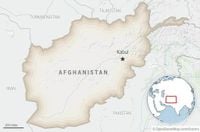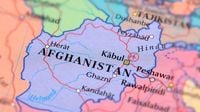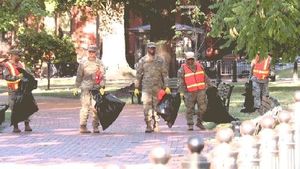Tragedy struck Afghanistan yet again this week, as a passenger bus overturned in the early hours of August 27, 2025, in the Arghandi area of Kabul, leaving at least 25 people dead and 27 more injured. The devastating accident, which occurred on the Kabul–Kandahar highway, has brought renewed attention to the country’s ongoing struggle with road safety, just days after another catastrophic bus crash in the western province of Herat claimed the lives of nearly 80 people.
According to multiple reports, including those from the Associated Press and TOI World Desk, the ill-fated bus was a 580-model coach traveling north from the southern provinces of Helmand and Kandahar toward the Afghan capital. The journey, which should have been routine for the many passengers seeking work, family reunions, or medical care in Kabul, ended in disaster when the vehicle veered off the road and plunged into a ravine in the Arghandi area. Taliban officials confirmed the details shortly after the accident, with Interior Ministry spokesman Abdul Mateen Qani attributing the crash to reckless driving.
“Reckless driving caused the accident, which also injured 27 people,” Qani told reporters, as quoted by AP and Mathrubhumi. The bus, he explained, had been carrying passengers from Helmand and Kandahar, two provinces that have seen their own share of hardship in recent years. The tragedy unfolded just as dawn was breaking, turning a hopeful journey into a nightmare for dozens of Afghan families.
The crash site, located on the busy Kabul–Kandahar highway, is notorious among locals for its sharp turns and steep drop-offs. Witnesses described a scene of chaos and heartbreak, as emergency responders and bystanders rushed to pull survivors from the wreckage. The bus had reportedly lost control and careened off the road, tumbling into a ravine before coming to rest in a mangled heap of metal and shattered glass.
This accident is the latest in a string of deadly incidents on Afghanistan’s roads, which remain perilous due to a combination of poor infrastructure, limited enforcement of traffic regulations, and a culture of risk-taking behind the wheel. The Taliban authorities, who have governed the country since August 2021, have pledged to improve road safety, but progress has been slow amid ongoing economic and security challenges.
The sense of déjà vu is especially painful for many Afghans, as the Kabul crash comes just over a week after another horrific bus accident in Herat province. That earlier tragedy involved a bus carrying Afghan migrants deported from Iran, which overturned and killed 79 people, according to TOI World Desk and Taliban officials. The proximity of the two disasters has sparked widespread grief and frustration, with many calling for urgent action to prevent further loss of life.
Taliban authorities have launched an investigation into the latest crash, hoping to determine whether mechanical failure, driver fatigue, or other factors may have contributed alongside the reckless driving cited by the Interior Ministry. For now, families of the victims are left to mourn their loved ones, many of whom were breadwinners supporting relatives in some of Afghanistan’s most impoverished regions.
“The bus was coming from southern Afghanistan with passengers from Helmand and Kandahar,” reiterated Abdul Mateen Qani, as reported by various news outlets. The journey from these provinces to Kabul is a lifeline for many, offering opportunities not available in rural areas. But the risks of travel are ever-present, especially on routes like the Kabul–Kandahar highway, where traffic accidents are all too common.
Afghanistan’s transportation infrastructure has long suffered from neglect, war damage, and underinvestment. Decades of conflict have left roads riddled with potholes, bridges in disrepair, and few reliable safety features such as guardrails or warning signs. Adding to the danger are aging vehicles, many of which are poorly maintained or overloaded well beyond their intended capacity.
In the aftermath of the Kabul crash, questions are swirling about what more can be done to protect travelers. Some observers point to the need for stricter licensing requirements and better driver education, while others emphasize the importance of investing in road repairs and modernizing the country’s vehicle fleet. The Taliban government, for its part, has promised to review current safety standards and step up enforcement against reckless driving, though critics argue that meaningful change will require international assistance and a sustained commitment to reform.
The grief is palpable not just in Kabul, but across Afghanistan, where news of yet another deadly accident has fueled a sense of national mourning. Social media has been flooded with messages of condolence and calls for action, as citizens grapple with the reality that road travel remains one of the most dangerous aspects of daily life. For many families, these tragedies are compounded by economic hardship, as the loss of a wage earner can plunge entire households into poverty.
“This incident followed another devastating bus accident less than a week ago in the western province of Herat that resulted in approximately 80 deaths,” noted Mathrubhumi, underscoring the scale of the crisis. The Herat crash, which involved Afghan migrants recently deported from Iran, highlighted the vulnerability of those forced to travel long distances under difficult circumstances. In both cases, survivors have recounted harrowing experiences and called for greater accountability from authorities and transportation companies alike.
As the investigation into the Kabul bus crash continues, the Taliban government faces mounting pressure to deliver answers and prevent future tragedies. The challenge is immense: Afghanistan’s roads are among the most dangerous in the world, and the resources needed to overhaul the system are in short supply. Yet for the families of the victims, the need for change could not be more urgent.
In a country where hope and hardship often go hand in hand, the latest bus crash in Kabul is a stark reminder of the human cost of neglect and inaction. The names and faces of those lost may fade from the headlines, but their stories endure—urging Afghanistan, and the world, not to look away.







